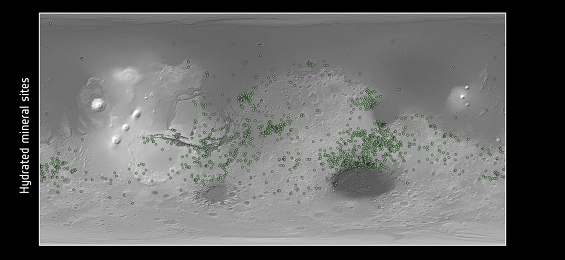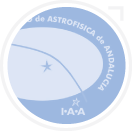Surface
The surface of a planet contains information on its evolution. Variations in surface composition are caused by internal activity, meteoritic impacts and atmosphere interaction. Abundant knowledge on Mars surface composition has been acquired from recent space VIS and IR measurements. Nanophasic iron oxides and mafic mineral assemblages, indicative of basaltic rocks, are typical of bright and dark terrains, respectively. Phyllosilicate and sulphate minerals have been observed on local deposits, mainly on ancient regions. The identification of hydrated minerals (e.g. phyllosilicates-bearing deposits) on Mars provides information about its aqueous history and is important evidence that liquid water was present on the surface or in the subsurface in the early history of the planet.
Space imaging spectrometers from visible to thermal infrared, like OMEGA/MEX, observe not only the solar light reflected by the surface and the planetary thermal emission but also the contribution of the atmosphere (aerosols and gaseous species). Aerosols increase (decrease) dark (bright) regions reflectance. Atmospheric gases may mask surface mineral absorption features. The isolation of the surface reflectance is mandatory for a correct surface mapping and minerals identification from these measurements. Most techniques used for decoupling the atmospheric and surface components address only the removal of atmospheric gases. The Monte Carlo approach of Vincendon et al. (2007) allowed also the determination of the aerosol optical depths from OMEGA near-infrared high latitude spectra.

Maps showing distribution of (top) ferric oxides, a mineral phase of iron and (bottom) dust, across the surface of Mars,
Credits: ESA/CNES/CNRS/IAS/Université Paris-Sud, Orsay; Background image: NASA MOLA
Our goal is to develop a generic new method to retrieve aerosol-free-reflectance maps from 0.4 to 4 µm, with a first application to a large OMEGA sub-dataset. We will start from a similar approach to that of Vincendon et al. (2007). We will use for our simulations the ARS multiple-scattering radiative transfer code. We will take as initial guess the dust opacity from simultaneous PFS/MEX observations in the thermal infrared and, where not existing, interpolations of other instruments measurements. The atmospheric state (temperature and pressure) will be taken from the Mars Climate Database (MCD). Initially, we will assume the most recent constants for the atmospheric dust and the aerosols size from TES analyses by Wolff and Clancy (2003). But, when available, we will use UPWARDS new and improved dust properties. The latter constitutes an exclusive chance offered by this project, since new information about aerosols (size distributions and opacities) will be provided within a parallel effort.
Using the OMEGA aerosol-free-reflectance maps generated, we will investigate the Martian surface diversity, correlate zones of ice and clathrate deposits, and investigate the seasonal and annual albedo changes due to dust redistribution.
Dedicated Work Package: WP3
Links to other UPWARDS activities: WP4, WP5, WP9
Langevin et al., Science, Vol. 307, pp. 1584-1586 (2005)
McGuire et al., Planet. Space Sci., Vol. 57, pp. 809-815 (2009)
Bakker et al., Planet. Space Sci., Vol. 90, pp. 1-9 (2014)
Vincendon et al., J.Geophys. Res., Vol. 112, E08S13 (2007)
Ignatiev et al., Planet. Space Sci., Vol. 53, pp. 1035-1042 (2005)
Määttänen et al., Icarus, Vol. 201, pp. 509-516 (2009)
Montabone et al., paper presented at the 5thInternational Workshop on the Mars Atmosphere: Modelling and Observations, Oxford, UK (2014)
Forget, et al., J.Geophys. Res., Vol. 104, pp. 24155-24176 (1999) 40Wolff et al., J. Geophys.Res., Vol. 114, E00D04 (2009)
Wolff & Clancy, J. Geophys. Res., Vol. 108, E05097, (2003) 42Poulet et al., J.Geophys. Res., Vol. 112, E08S02 (2007) 43Carrozzo et al., J.Geophys. Res., Vol. 117, E00J17 (2012)
Ody et al., J.Geophys. Res., Vol. 118, pp. 234-262 (2013)

































